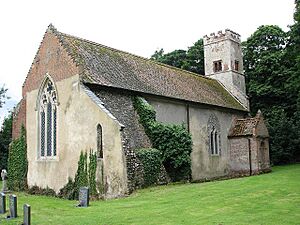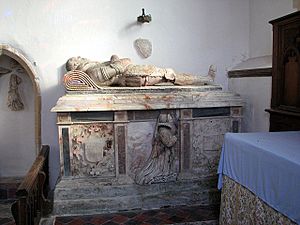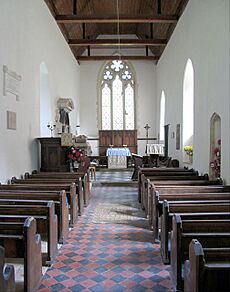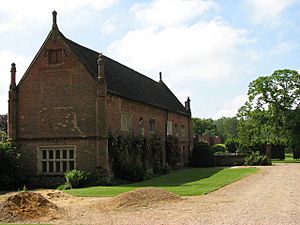Oxnead facts for kids
Quick facts for kids Oxnead |
|
|---|---|
 St Michael's Church, Oxnead |
|
| Civil parish | |
| District |
|
| Shire county | |
| Region | |
| Country | England |
| Sovereign state | United Kingdom |
| EU Parliament | East of England |
Oxnead is a historic place in Norfolk, England, near Aylsham. It was once a small village but is now mostly known for its old church, St Michael's, and Oxnead Hall. The Hall was the main home of the important Paston family for many years, from 1597 until 1732. Famous sculptor Nicholas Stone created several artworks for Oxnead Hall when Sir William Paston lived there. In 1931, only 66 people lived in the area.
Contents
Discovering Oxnead's Past
How Oxnead Got Its Name
Oxnead gets its name from the nearby meadows and a river called the Ouse. This name was used by both the ancient Britons and the Saxons. In 1086, a big survey called the Domesday Book recorded Oxnead. At that time, the land was worth 30 shillings and included a church.
Over the centuries, Oxnead changed hands many times. Around 1368, Sir Robert de Salle owned the estate. Later, in the 1420s, it was sold to William Paston, whose family would make Oxnead famous. On 1 April 1935, Oxnead officially became part of the nearby parish of Brampton.
The Powerful Paston Family at Oxnead
The Paston family was very important in Norfolk. William Paston, a lawyer and judge, gave the Oxnead estate to his wife, Agnes. The estate stayed in the family for generations.
Sir Clement Paston (1515–1597) Sir Clement Paston was a brave seaman and built the first Oxnead Hall. He was born near the sea and loved ships. King Henry VIII called him his "Champion," and Queen Elizabeth I called him her "Seaman." In 1546, he captured a French admiral and received a large ransom!
Clement married a wealthy woman named Alice. Her money helped him rebuild Oxnead Hall. He wanted a "fair and convenient tomb" for himself and his wife in Oxnead church.
Later Pastons and Their Legacy After Clement, his nephew, Sir William Paston (1528–1610), inherited Oxnead. This Sir William founded the Paston Grammar School in North Walsham.
His grandson, Sir William Paston (1610–1663), was a big fan of art and poetry. He hired Nicholas Stone, a famous sculptor, to create statues for his house and gardens at Oxnead. Sir William's first wife, Lady Katherine Bertie, sadly died during childbirth in 1636 and was buried at Oxnead.
Sir William's son, Sir Robert Paston (1631–1683), became the 1st Earl of Yarmouth. Like his father, he loved collecting books, paintings, and jewels. He even built a special banqueting hall for King Charles II's visit in 1671. However, his spending led to money problems, and he had to sell parts of his land.
The last of the Paston family line was William Paston (1653/4-1732), the 2nd Earl of Yarmouth. He married King Charles II's daughter, Lady Charlotte Fitzroy, but continued to have huge debts. After his death, the family's titles ended. Oxnead Hall fell into disrepair, and most of it was pulled down.
St Michael's Church: A Historic Landmark
St Michael's Church is mostly from the 1200s. It is built from flint stone. Later additions, like the top of the tower and two porches, were made from brick between the 1500s and 1700s.
Inside the church, you can see a monument to Sir Clement Paston. It shows him lying down, with his wife Lady Alice kneeling beside him. There is also a beautiful monument to Lady Katherine Paston, created by the famous sculptor Nicholas Stone. The church also has a font from the 1600s.
Oxnead Hall: A Glimpse of Grandeur
Sir Clement Paston first built Oxnead Hall around 1580. Later, Nicholas Stone redesigned parts of it for Sir William Paston between 1631 and 1632. At its largest, the Hall had 79 rooms! However, after the Earls of Yarmouth faced financial troubles, the house began to fall apart. By 1744, it was described as "ruinous."
Today, only a two-story service wing of the original Hall remains. This part has special windows with vertical and horizontal bars. A newer section was added in the 1800s, and people still live in the Hall today.
Sadly, none of the garden statues created by Nicholas Stone for Oxnead remain here. However, one of his statues, a Hercules, can now be seen at Blickling Hall. Blickling Hall also has a fountain that was bought from Oxnead in 1732.
In 2016, the gardens of Oxnead Hall were opened to the public for a charity event.
Oxnead Mill: A Working History
Across the River Bure stands Oxnead watermill. This four-story building was built in 1851. There has been a mill at Oxnead since the time of the Domesday Book in 1086!
From about 1716 to 1822, the site was a paper mill. Then, it made blankets before being rebuilt in 1851 as a flour mill. In 1940, the mill went back to making paper.




